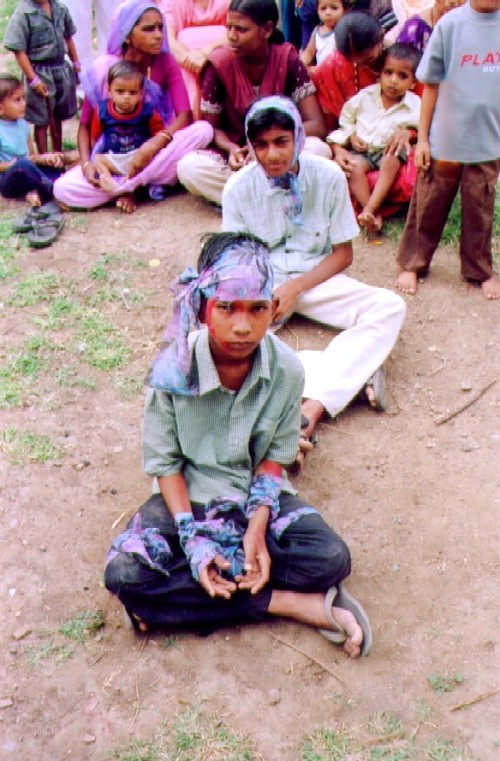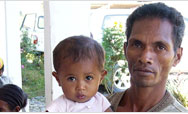You are here » Home » Telling Our Story
Success Story
Bringing response skills to villages helps mitigate damage from future disasters
Hazard-prone Areas Run Disaster Drills

| |
Photo: USAID/Virginia Foley
|
|
Neighbors helped bandage this mock victim for a disaster-response drill.
Thikaria's disaster team made a map with every house in the village, noting who
lives where and charting which houses are strong enough to withstand an earthquake — and which are not.
|
The sound of a siren permeates the tranquil village, interrupting grazing cattle and residents
going quietly about their daily lives. Suddenly everything changes. Children flow out of the
schoolhouse and head for the trees where village women have already gathered. Village men search
houses and find one student covered with red markings to simulate blood. Two poles and a shirt are
used to form a make-shift stretcher for the boy, and a sari-clad woman bandages him. A water truck
passes by as residents simulate doling out food out of a cooking pot.
The 500 villagers of Thikaria in Rajasthan, India, are practicing for a disaster. Visitors and
advisors stand by taking notes: How ready will this village be if a disaster should happen?
In addition to being prone to natural disasters like earthquakes, droughts and floods, India is
also vulnerable to emergencies such as fire, epidemics, and chemical spills. The 1999 Orissa cyclone,
the 2001 Gujarat earthquake and the 2004 Indian Ocean tsunami all illustrated the need for response
techniques that would minimize the damage done by a range of disasters.
In September 2003, USAID launched a program to build the public sector's capacity to deal with
disasters, reinforce the use of climate forecasts and early warning systems, and establish disaster
management systems both for the government and for communities.
After residents are trained in response skills, villages like Thikaria participate in drills where
10-20 residents coordinate groups to conduct search and rescue operations, provide first aid, secure
water and sanitation, manage shelters and counsel trauma victims.
To assess the damage after a disaster Thikaria's disaster team made a map with every house in
the village, noting who lives where and charting which houses are strong enough to withstand an
earthquake — and which are not. In the event of a disaster, the closest medical facility is 13 miles
away, and phone lines may be downed, so first aid must begin in the village. Thanks to the disaster
training and drills, Thikaria is now ready for that contingency and will be able to function on its
own for 24 — 48 hours after a disaster.
Print-friendly version of this page (40kb - PDF)
Click here for high-res photo
Back to Top ^ | 

